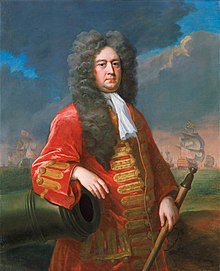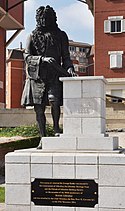George Rooke


Sir George Rooke (* 1650; † 24. Januar 1709) war ein englischer Marineoffizier, zuletzt im Rang eines Admiral of the Fleet.
Leben
Nachdem er sich als Freiwilliger zur Marine gemeldet hatte, diente er in den Seekriegen mit Holland und im Neunjährigen Krieg gegen Frankreich und wurde 1673 Kapitän sowie 1690 Konteradmiral. Er nahm an den Schlachten von Bantry Bay (1689), Beachy Head (1690) und Barfleur / La Hougue (1692) teil und wurde nach letzteren am 20. Februar 1693 zum Knight Bachelor („Sir“) geschlagen.[1] In der Seeschlacht bei Lagos 1693 unterlag er auf dem Weg ins Mittelmeer Admiral Tourville. 1700 leitete er das englische Geschwader, das den Schweden die Invasion auf Seeland in Dänemark ermöglichte.[2]
1702 leitete er die fehlgeschlagene Expedition nach Cádiz, konnte aber auf dem Rückweg bei Vigo die spanische Schatzflotte abfangen. Gemeinsam mit Sir Cloudesley Shovell und Prinz Georg von Hessen-Darmstadt eroberte er 1704[3] die Festung Gibraltar und verhinderte in der Schlacht bei Vélez-Málaga den französischen Entsatz durch Toulouse und d’Estrées. Hierbei erlitt seine Flotte jedoch hohe Verluste. George Rooke trat 1705 aus dem Dienst.
Literatur
- Rooke, Sir George. In: Encyclopædia Britannica. 11. Auflage. Band 23: Refectory – Sainte-Beuve. London 1911, S. 705 (englisch, Volltext [Wikisource]).
Weblinks
- Sir George Rooke (1650-1708/9) auf threedecks.org (englisch)
- National Portrait Gallery
Einzelnachweise
- ↑ William Arthur Shaw: The Knights of England. Band 2. Sherratt and Hughes, London 1906, S. 268.
- ↑ Abel Boyer: The interest of Great-Britain: with relation to the differences among the Northern potentates consider’d. In which is contain’d … I. A narrative of the principal actions occurring in the wars betwixt Sweden and Denmark, … written in in [sic] the year 1675. By Sir Philip Meadows … II. An account of Sir George Rook’s expedition … in the year 1700, … written by the Reverend Mr. Beauvoir, … III. Also an account of the negotiations … before and after the Treaty of Travendahl, … To which is added by way of appendix, an account of the rarities … observed by Mr. Beauvoir … J. Baker and T. Warner, London 1716. Umfang: xvi,176,31,[1]p.; 8°
- ↑ George Rooke: Relation des Admiral Rooks von dem in der mittelländischen See vorgegangenen grossen Seetreffen. [s. l.], [1704].
| Vorgänger | Amt | Nachfolger |
|---|---|---|
| Edward Russell | Vice-Admiral of England/Great Britain 1702–1709 | James Berkeley |
Edward Russell Cloudesley Shovell | Commander-in-Chief, Mediterranean Sea 1695–1696 1704 | John Nevell John Leake |
| Personendaten | |
|---|---|
| NAME | Rooke, George |
| KURZBESCHREIBUNG | englischer Admiral |
| GEBURTSDATUM | 1650 |
| STERBEDATUM | 24. Januar 1709 |
Auf dieser Seite verwendete Medien
Autor/Urheber: Gibnews, Lizenz: CC BY 3.0
Statue of Admiral George Rooke who captured Gibraltar in August 1704
| Caption from the museum's website |
|---|
|
A three-quarter-length portrait to the right of Admiral Sir George Rooke, Admiral of the Fleet. He wears a gold-braided red cloth coat with wide sleeves, grey-brown full-bottomed wig and a white neck-cloth. His right arm rests on the muzzle of a cannon and he holds a telescope in his left hand. Behind him in both the right and left backgrounds, is a depiction of the Battle of Malaga, 1704. Admiral Rooke's flagship, the 'Royal Katharine' with the Union flag at the main, is seen in port-quarter view, engaging the 'Foudroyant', which was the flagship of the Franco-Spanish fleet under the Comte de Toulouse, an illegitimate son of Louis XIV. Though inconclusive, the Battle of Malaga was the only fleet action fought at sea during the War of the Spanish Succession. This portrait is one of a series commissioned for the Royal Collection at the time of Queen Anne and was presented to Greenwich Hospital by George IV in 1824. The Swedish painter travelled to London in 1682, where he became acquainted with Godfrey Kneller. In 1685, he left for Europe and returned to London in 1689 where he remained. During Dahl's absence, Kneller consolidated his supremacy as the fashionable portrait painter, although the prolific Dahl was his closest competitor. Politically, Kneller supported the ascendant Whigs, while Dahl was a Tory. The death of Kneller in 1723 left Dahl the principal London portraitist. |

